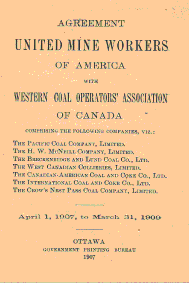
Although coal mining in the Lethbridge area was a major industry, it was always marked by instability. Fluctuations in the demand for coal directly effected employment levels in the area. Cold winters produced a high demand for coal which created employment. On the other hand, hot summers and warm winters produced less demand and created high unemployment.
Since domestic coal was very much a seasonal product, there was always a well-founded fear of unemployment among miners. There is data for a period in the 1930's which indicates that full-time miners worked for only 138 days of the year and that the majority of miners were not fully-employed. A two to three day work week was the norm, except in boom times such as the two World Wars. Thus, coal mining was a boom and bust industry and a highly unstable occupation at best.
Strikes became a frequent event, instigated by which ever side was in a position to put economic pressure on the other. In the early days, the length of a possible strike was figured by asking the question, "Did they bring up the ponies?" It was thought that if the miners did not bring the ponies up it could be assumed that the strike would be short lived because miners would not permit the animals to go unattended for very long. If the miners did bring the ponies up, then one could assume that the strike leaders were serious and that the strike might go on for weeks, or even months.

P19720046790-GM Cover of a booklet containing the labor contract between laborers and owners in 1907.
One particular strike grabbed national attention in 1906. The coal workers' demands for higher wages and a decrease in working hours were rejected and a strike ensued. Initially, the strike was peaceful, but when the Galt company hired 100 men to keep the mine open, the situation became worse. Policemen protecting the replacement workers were attacked, and on two occasions explosives were used on the homes of the these workers. The fear of a coal shortage prompted the government to get involved, and the strikers were eventually provided with a few incentives to return to work. The situation contributed to the passage of the first Workers Compensation Act by the Canadian government in 1907 and the legislation of an eight-hour work day in 1908. The federal government also enacted the Industrial Disputes Investigation Act in 1907. Still, these measures were insufficient for many workers, and a wave of strikes lasting from three to eight months occurred in 1909, 1911, 1919, 1922, 1923, and 1924.
Previous Page | Exhibit Contents | Home | Navigation Information | Glossary | Curriculum Guide | Next Page
Copyright © 1996 Sir Alexander Galt Museum. All rights reserved.